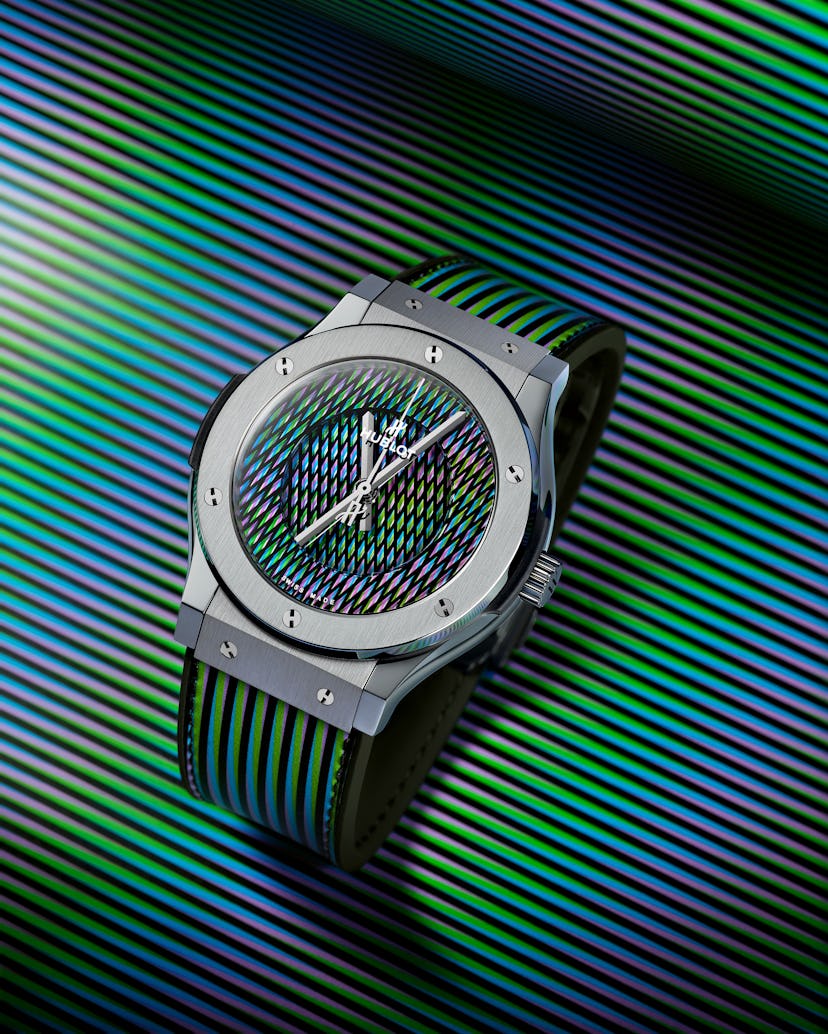Artist Carlos Cruz-Diez Put a Kinetic Artwork Inside a Watch
The legendary Franco-Venezuelan artist created the world’s trippiest watch with Hublot.

Famed kinetic artist Carlos Cruz-Diez—who passed away this past July at the age of 95—once said that a work of art “needs the viewer’s participation in order to become real. It’s not about passive contemplation, but an active participation.”
Cruz-Diez, a Venezuelan artist who settled in Paris in the 1960s, was a leader of the Op Art Movement, and made dizzyingly abstract work in which rigid lines of color swirl into one another. “Active participation” becomes a necessity when viewing his visceral, overwhelming paintings and installations; the eye moves and rattles as it scans a piece. He wanted to flood the senses with color.
In 1975, the artist wrote a piece on color theory that summarized his goals for his practice, asking his audience to think of color as “a reality which acts on the human being with the same intensity as cold, heat, sound, and so on.”
Carlos Cruz-Diez’s “Chromosaturation” installation is displayed as part of the Light Show at the Hayward Gallery in 2018.
Works like Cruz-Diez’s “Physichromies” series, in which strips of multi-colored cardboard and plexiglass create a disorienting effect, are rendered with extreme precision. As a child, he was inspired by watching light go through soda bottles at the soft drink factory where his father worked, and as an adult he studied the experiments of Sir Isaac Newton; rigor and scientific precision were essential to his practice. And so it makes sense that he would be drawn to watchmaking. In 2015, he released his first collaboration with the Swiss luxury watch company Hublot.
And four years later, the same label has unveiled a second collaboration, this time as a limited edition timepiece called the Classic Fusion Cruz-Diez, launched at Art Basel Miami Beach.
Cruz-Diez’s pieces for Hublot are complex. As opposed to a simple flat rendering on a watch face, they’re little works of kinetic art—as the hands of the watch turn, different-colored discs come forward (one connected to the minute hand, one to the second hand), creating a constantly changing composition. A watch has never looked so trippy. Observing the hands turn and the colors change creates a similar effect to walking through the artist’s installations, honoring his theory that color is a “continuous present.” Only 300 of the styles have been produced, available in materials including titanium, gold, and ceramic.
“It’s a living piece of art, linked to time,” said Hublot CEO Ricardo Guadalupe in an interview at the watch’s launch on Thursday at the Espace Expression Gallery in Miami. “I think this kind of kinetic output works really well in a watch. To just do a painting in a watch is nothing special. But this is specific, and so it works.”
Cruz-Diez’s son, Carlitos Cruz, reaffirmed his father’s passion for machinery and science. “My father loved watches,” said Cruz. “He visited the factory and was immediately fascinated by the machines, the precision. He was like a child, so happy with the machines.”
The Cruz’s are a tight-knit family, and various relatives run branches of the Cruz-Diez Foundation all over the world. Cruz-Diez strongly believed that art and life were one and the same, bringing his family into his studios to help with his work, a contrast to the stereotype of the neglectful, solitary male artist. His son spoke passionately about his father’s work, with great pride. He loved the new collaboration with Hublot. But he also likes to wear an Apple Watch.